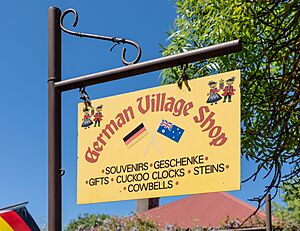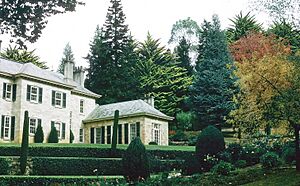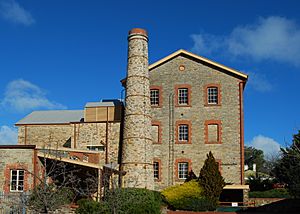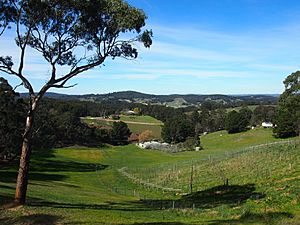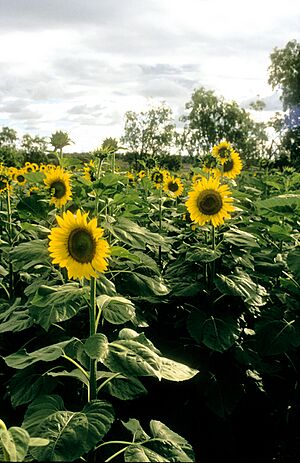Adelaide Hills facts for kids
Quick facts for kids Adelaide HillsSouth Australia |
|
|---|---|
|
From top to bottom, left to right: Vineyards in the Adelaide Hills wine region, St Paul's Lutheran Church, Hahndorf, scarecrow sculpture at Mount Lofty House, Strathalbyn railway station yard, German architecture at Hahndorf, autumn foliage at Mount Lofty, hall at One Tree Hill and the Main Street of Lobethal
|
|
| Population | 72,260 (2016 census) |
| Established | Early 1800s |
| LGA(s) | Adelaide Hills Council District Council of Mount Barker |
| State electorate(s) | Kavel, Heysen, Morialta, Schubert |
| Federal Division(s) | |
The Adelaide Hills is a beautiful region in South Australia. It is located east of the city of Adelaide, within the southern Mount Lofty Ranges. The largest town here is Mount Barker, which is growing very quickly.
Long ago, before European settlers arrived, the Peramangk people lived in the Adelaide Hills. The Adelaide Hills wine region is also part of this area, known for its vineyards above 300 meters.
Contents
History of the Adelaide Hills
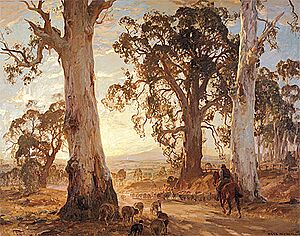
The Peramangk people were the first inhabitants of the Adelaide Hills. Their land stretched from the foothills up to areas like Mount Barker, Gumeracha, and Mount Pleasant. It also went south to Strathalbyn and towards the River Murray.
The Adelaide Hills were among the first places in South Australia where European settlers made their homes. Many towns, like Hahndorf and Lobethal, were started by German settlers. You can still see their original town names and building styles today. Many people of German background still live in the area.
In the early days of the colony, wood was cut down in the hills and taken to Adelaide. This wood was used to build new houses and other buildings. The hills were then called "the Tiers" and the woodcutters were known as "tiersmen."
The strong German culture is still very clear. There are many Lutheran churches and schools. Some older residents even still speak German. A special tradition, the Lobethal Christmas lights, started in the 1950s and is very popular.
Culture and Fun Things to Do

Many people from Adelaide enjoy driving through the hills. It's a popular activity because the hills are very close to the city. Most Adelaide residents live within 20 kilometers of the hills.
Living in the Adelaide Hills offers the best of both worlds. You get a friendly country community, but you are still close to the city. It's easy to travel to Adelaide for work or school. This area has become even more popular since new roads and tunnels were built, making travel easier.
The Heysen Tunnels, completed in 1999, are named after Sir Hans Heysen. He was a famous local artist whose home and studio, "The Cedars," is now a cultural site near Hahndorf. Hahndorf is still a lively place for artists and craftspeople.
Adelaide Hills Wine Region
The Adelaide Hills wine region includes all parts of the Hills that are higher than 300 meters. This higher elevation means cooler nights, even in summer. This helps the grapes grow better and gives the wines a richer flavor. The area also gets more rain.
The Adelaide Hills is one of Australia's oldest wine regions. The first grapevines were planted here in 1839. This was only three years after South Australia became a province. The first wines were made in 1843.
Cool Attractions to Visit
The Mount Lofty area is a great spot to visit. It has a lookout where you can see amazing views. There's also a restaurant and a fire-spotting tower.
In Gumeracha, you can find the Big Rocking Horse. It's the largest rocking horse in the world, standing over 18 meters tall! That's about as tall as a six-story building. You can visit it, and it advertises a nearby wooden toy factory and wildlife park.
The National Motor Museum is located in Birdwood. It's a fantastic place to see many different types of cars and motorcycles.
Exciting Events
The National Motor Museum is the end point for the "Bay to Birdwood" event. In this event, up to 5,000 old cars and motorbikes drive from Glenelg through the city and hills to the museum. It's a 70-kilometer journey, and a big festival is held at the end. There are two types of Bay to Birdwood events held in different years for different age groups of vehicles.
The Tour Down Under is a big bike race that happens every year. It uses some of the best cycling routes in South Australia, including those in the Hills.
The Adelaide Hills also hosts the annual Medieval Fair in Gumeracha every April. You can see live jousting, blacksmithing, and dance shows. People often dress up in costumes. There's also the English Ale Festival in May. These festivals are popular because many people from Britain live in the Hills.
Throughout the year, you can find folk music sessions and concerts in small towns like Mt Pleasant, Mylor, and Balhannah.
Protected Natural Areas
The Hills region is home to Cleland National Park. Inside it is the Cleland Wildlife Park, where you can see kangaroos, wallabies, and emus roaming freely. There are also special areas for dingos, koalas, native birds, and snakes. It's a popular place for school trips and visitors.
You can find many native animals in the hills. Common ones include the kookaburra, tawny frogmouth, southern brown bandicoot, and brown tree frog. Less common animals include the antechinus and the heath monitor.
There are many walking and bike trails in the Hills. Part of the famous Heysen Trail goes through here. This trail stretches all the way from the Fleurieau Peninsula to the Flinders Ranges. Birds you might see include colorful parrots like the Adelaide rosella and rainbow lorikeet. You might also spot large Major Mitchell's cockatoos and yellow-tailed black cockatoos. Smaller birds like the superb blue wren are also common.
Local Facilities
Sports and Fun
Sports and recreation are very popular in the hills. Many people play Australian rules football, cricket, and soccer. The Basket Range Oval is home to the Basket Range Cricket Club.
Local News
The Courier is a small, independent newspaper published weekly in Mount Barker. It covers news for many towns in the Hills. It started in 1880 and has been printed every week since then. The same family, the Marstons, has owned it since 1954.
Climate
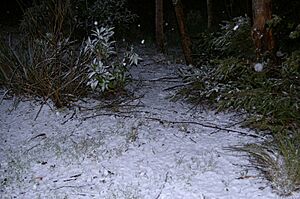
- Further information: Climate of Adelaide
The Adelaide Hills are usually a few degrees cooler than the city of Adelaide. January and February days are warm, but the nights are generally cool. This big difference between day and night temperatures means that even in summer, the average daily temperature is cool.
It snows lightly about once every three or four years. Sometimes, there's enough snow to stay on the ground for half a day. Also, large amounts of hail are more likely to fall here than on the flat plains.
Images for kids
-
A view across the southern parklands to the Adelaide Hills from South Terrace, Adelaide










